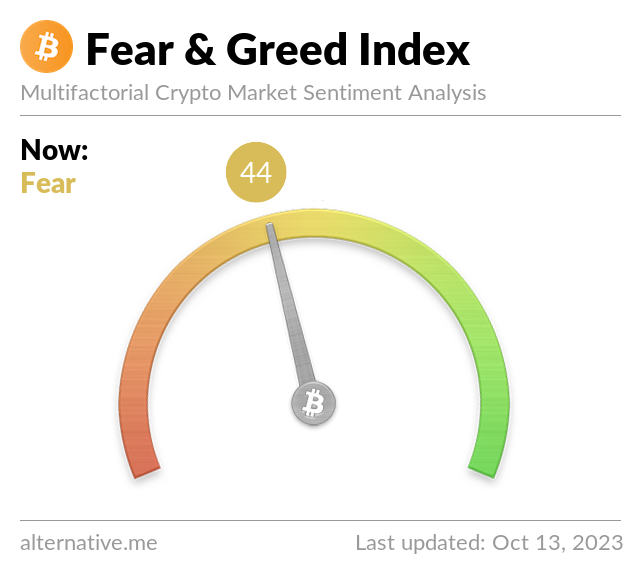Summing Up The Week
The relief rally that started last week continued throughout this week with markets shrugging off war in the Middle East along with higher-than-expected inflation readings. Believe it or not, this kind of price action falls right in line with the seasonal volatility we see this time of year.
In fact, an analyst on Macrovoices, one of my favorite weekly podcasts, predicted that the S&P 500 could bounce 3-5% before rolling over again and selling off to new lows. He’s been right so far… {dramatic chords here}
Let’s take a look at the news that moved the markets this week!
Market News
Hamas stages invasion against Israel
On Saturday, Hamas, a terrorist group backed by Iran, staged a full-scale invasion on Israel, catching the country off-guard and plunging the Middle East back into war, reported CNBC.
More than 700 Israelis were killed during the strike, called “Operation Al Aqsa Flood” by the Hamas, and at least 490 Palestinians were killed in retaliatory strikes from Israel on the Gaza Strip.
While the price of oil spiked nearly 5% – a typical reaction in times of war – stocks only pulled back slightly initially before rallying into the end of the day. Stocks’ reaction to these tragic events highlights the jarring disconnect investors must deal with when it comes to the stock market – markets “feel” nothing.
Wholesale inflation rose 0.5% in September, higher than expected
On Wednesday, the producer price index (PPI) for September increased 0.5% versus the 0.3% expected by economists potentially indicating inflation may be starting to increase once more, reported CNBC.
The PPI measures the cost for finished goods that producers pay, and while 0.5% was less than the 0.7% increase from August, the reversal in trend is not a good sign for the fight against inflation, particularly since the PPI is viewed as a leading indicator for inflation – an indication of what inflation will do in the future.
However, the more closely watched indicator, the Consumer Price Index (CPI), wouldn’t be released until Thursday. Perhaps because of this, the markets more or less shrugged off the hot PPI during morning trading.
CPI rose 0.4% in September, more than expected
On Thursday, the Consumer Price Index (CPI) for September increased 0.4% versus the 0.3% expected by economists, reported CNBC. “Core CPI,” which removes food and energy prices – which are considered more volatile – showed an increase of 0.3%, in-line with analyst expectations.
Where as the Producer Price Index (PPI) measures the costs for goods and services to companies, the CPI directly measures the costs of products and services for end consumers. As a result, many analysts view the CPI as a reliable indicator of the health of the U.S. consumer, and, by correlation, the health of the U.S. economy.
Stock market futures were positive going into the CPI print, and, initially, didn’t react to the print in any significant way. However, after the market opened, stocks rolled over and gave back their earlier gains as investors processed what these higher inflation numbers mean with the Federal Reserve most certainly staying higher for longer on interest rates.
Next Week’s Gameplan
The seasonal volatility is certainly not disappointing. Last week’s price action saw me add to many positions under weakness, however this week’s ongoing relief rally has left me on the sidelines.
At this point, none of my positions are near buying targets, yet none of them are close to profit-taking sell targets, either. Accordingly, as my long-term investing discipline dictates, my mandate is to hold and do nothing. I get to sit back, watch the price action, and wait for the market’s next move.
… which many, including Michael Gayed, an analyst who I greatly respect, believe may be coming next week in the form of a flight to U.S. Treasurys and a potential crash in equities.
As always, make a plan for both directions – what will you do if stocks go up and what will you do if stocks go down – and I’ll see you back here next Friday!.
This Week in Play
Stay tuned for this week’s episodes of my two portfolios Investments in Play and Speculation in Play coming online later this weekend!
Crytpo Corner

Bitcoin Price (in USD)
%
Weekly Change
Bitcoin Price Action
It’s Easy Come, Easy Go for Bitcoin…
As quickly as Bitcoin was able to instill confidence in the Bulls last week, it completely broke down on Wednesday when Bitcoin broke through the support it had set at $27,160.47, not finding new support until $26,521.32.
If the crypto’s new weekly support fails, we’ll be looking at $25,983.78, followed by the support Bitcoin found when it sold off in September down at $24,900.00. After that, it’s anyone’s guess with the most likely next candidate falling around $23,900. On the upside, Bitcoin now has to break resistance at $28,613.37, the rally high it saw last week.
If it can’t break either the high or the low, Bitcoin will meander in this price range until another catalyst develops.
The Bullish Case
Bulls now argue that the renewed rally in equities is drawing away interest from Bitcoin, claiming the new “safe haven” thesis means Bitcoin is no longer directly correlated to risk assets like tech stocks.
The Bearish Case
Bears continue to argue there is a correlation between Bitcoin and risk-on assets, suggesting that crypto may be a leading indicator to the potential selloff coming in the stock market later in October.
Bitcoin Trade Update
Current Allocation: 2.300% (+0.083% since last update)
Current Per-Coin Price: $27,541.46 (-$26.76 since last update)
Current Profit/Loss Status: -2.56% (-2.28% since last update)
My first buy filled on Monday at $27,303.30 (before fees). From there, two additional buys filled throughout the week on Wednesday and Thursday leaving me with an average buy price of $26,848.50 (after fees).
The buys lowered my per-coin cost -$26.76 from $27,568.22 down to $27,541.46 and increased my allocation +0.083% from 2.217% to 2.300%.
Bitcoin Buying Targets
Using Moving Averages and supporting trend-lines as guides, here is my plan for my next ten (10) buying quantities and prices:
0.027% @ $26,586
0.027% @ $26,303
0.027% @ $26,027
0.027% @ $25,813
0.027% @ $25,558
0.027% @ $24,937
0.054% @ $23,971
0.082% @ $23,032
0.234% @ $22,135
0.359% @ $21,473
Not Your Keys, Not Your Crypto…
In light of brokerage failures in 2022, I no longer keep any of my crypto on an exchange and I only keep enough USD on the exchanges I use to execute my next few buys. I use multiple cold wallets from the brands Ledger and Trezor to hold my crypto (click the links to access the direct sites, and I receive no affiliate benefits from these links).
Additionally, I have now divided my allocated USD between two different exchanges – Gemini and Coinbase – in case one (or both) becomes insolvent. Disclaimer: We both receive a bonus if you use either my Gemini or Coinbase referral links to open accounts.
I do not trust anyone in the space, even with Coinbase (COIN) being publicly traded (and one of my own Investments in Play positions).
No price target is unrealistic in the cryptocurrency space – Bullish or Bearish.
While traditional stock market investors and traders may think the price targets in the cryptocurrency space are outlandish due to the incredible spread (possible moves include drops of -90% or more and gains of +1000% or more), Bitcoin has demonstrated that, more than any speculative asset, its price is capable of doing anything.
Here are some of Bitcoin’s price movements over the past couple of years:
- In 2017, Bitcoin rose +2,707% from its January low of $734.64 to make an all-time high of $19,891.99 in December.
- Then, Bitcoin crashed nearly -85% from its high to a December 2018 low of $3128.89.
- In the first half of 2019, Bitcoin rallied +343% to $13,868.44.
- In December, Bitcoin crashed -54% to a low of $6430.00 in December 2019.
- In February 2020, Bitcoin rallied +64% to $10,522.51.
- In March , Bitcoin crashed nearly -63% to a low of $3858.00, mostly in 24 hours.
- Then, Bitcoin rallied +988% to a new all-time high of $41,986.37 in January 2021.
- Later in January 2021, Bitcoin dropped -32% to a low of $28,732.00.
- In February, Bitcoin rallied +103% to a new all-time high of $58,367.00.
- Later in February, Bitcoin dropped -26% to a low of $43,016.00.
- In April , Bitcoin rallied +51% to a new all-time high of $64,896.75.
- In June , Bitcoin crashed -56% to a low of $28,800.00.
- In November, Bitcoin rallied +140% to a new all-time high of $69,000.00.
- In November 2022, Bitcoin crashed -78% to a low of $15,460.00.
- In April 2023, Bitcoin rallied +101% to a high of $31,050.00.
- In June, Bitcoin dropped -20% to a low of $24,750.00
- In July, Bitcoin rallied +29% to a high of $31,862.21.
- In September, Bitcoin dropped -22% to a low of $24,900.00.
Where will Bitcoin go from here? Truly, anything is possible…
What if Bitcoin’s headed to zero?
The only reason I speculate in the cryptocurrency space is I truly believe Bitcoin isn’t headed to zero.
I am prepared for that possibility, however, by knowing I could potentially lose all of the capital I’ve allocated to this speculative investment. Professional advisers recommend speculating with no more than 5% of an investor’s overall assets. Personally, I’ve allocated less than that to speculating in crypto.
I feel that anyone who doesn’t fully believe in the long-term viability of cryptocurrency would be better served not speculating in the space.
On a good day, this asset class isn’t suitable for those with weak stomachs. On volatile days, the sector can induce nausea in the most iron-willed speculator. If a speculator isn’t confident in the space, the moves will cause mistakes to be made.
DISCLAIMER: Anyone considering speculating in the crypto sector should only do so with funds they are prepared to lose completely. All interested individuals should consult a professional financial adviser to see if speculation is right for them. No Get Irked contributor is a financial professional of any kind.
Ways to give back to GetIrked:
Send me a tip via Stripe! Thank you!
Get free money by signing up for an account with my referral link for Schwab
Sign up for Gemini and we each get $10
Click this referral link to get the Brave Browser
If you use Brave, you can also use the Tip function to tip me in Basic Attention Token (BAT).
Suicide Hotline – You Are Not Alone
Studies show that economic recessions cause an increase in suicide, especially when combined with thoughts of loneliness and anxiety.
If you or someone you know are having thoughts of suicide or self-harm, please contact the National Suicide Prevention Lifeline by visiting www.suicidepreventionlifeline.org or calling 1-800-273-TALK.
The hotline is open 24 hours a day, 7 days a week.


